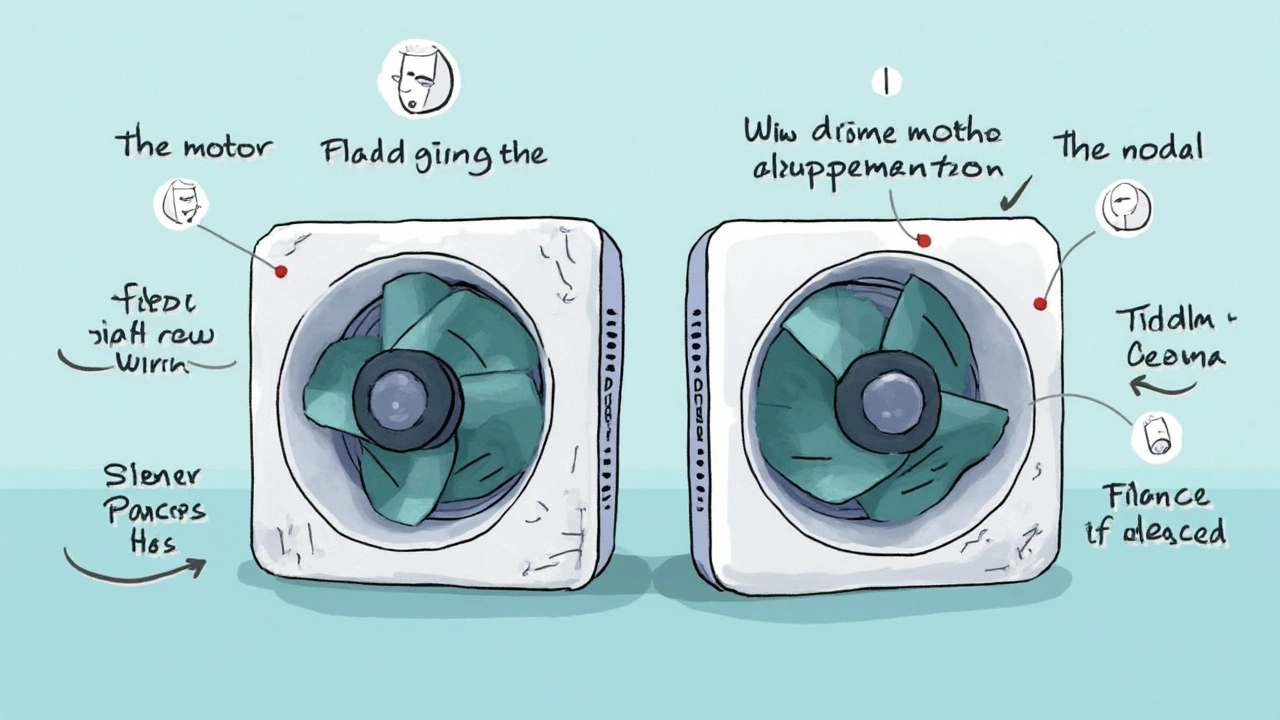So, your extractor fan just quit. It’s quiet, maybe a little too quiet, and you’re probably sniffing a bit more kitchen smoke or getting steamed up after a shower. Turns out, these fans are pretty simple, but when they go dark, the cause can range from dead-easy to what-the-heck complicated. Knowing the main trouble spots is half the battle.
First thing’s first—don’t jump to buy a new fan until you’ve figured out what stopped yours in the first place. Even expensive fans can tap out for totally fixable reasons. Sometimes it’s a tiny switch or a loose wire that’s to blame. Other times, a motor has just done its last spin. Either way, we’ll check out all the likely suspects, so you don’t waste time or money.
- Dead Power Supply or Switch
- Motor Trouble and Wear
- Clogged Filters and Ducts
- Sticky Blades and Obstructions
- When DIY Hits a Wall
Dead Power Supply or Switch
If your extractor fan suddenly won’t turn on, the very first thing to check is the power supply and the switch—this trips up more folks than you’d think. Even brand-new fans can seem dead if they’re not getting any juice. One blown fuse or tripped circuit breaker, and you’re stuck with stale air.
Before you start unscrewing anything, flick the wall switch off and back on. Sound too simple? You’d be surprised how many people miss this. No luck? Test if other electrical things in the room work—maybe a hair dryer or your bathroom light. If those are dead too, you could be dealing with a bigger power issue instead of just a cranky fan.
If the room has power but the fan’s still silent, the next culprit is the switch itself. Sometimes the wiring behind the switch gets loose, especially in older houses where wires can wiggle free over time. Here’s a quick way to check:
- Turn off the main breaker—don’t skip this, safety first!
- Remove the switch cover and see if wires are tight and secure.
- If any wire looks loose, tighten it up and pop the cover back on.
Still dead? Grab a cheap voltage tester (you can find one at any hardware shop). With the power back on, carefully check if voltage is reaching the fan’s wires. If not, then the cable or switch is probably the issue.
One quick tip: In bathrooms, fans often share power with the lights, so if your extractor fan and lights both fail at once, that’s almost always a supply or breaker issue.
Still nothing? Now things might get a bit more involved—time to move on to the fan itself or call in a pro if you’re not comfortable with wiring.
Motor Trouble and Wear
If your extractor fan refuses to spin or just makes a weird buzzing sound, the motor is one of the main culprits. Over time, even the best extractor fan motors wear down. In fact, most run for years right above hot stoves or steamy showers—conditions that aren’t exactly motor-friendly.
You might notice the fan is getting slower, noisier, or just plain stops. A worn-out motor can’t push air like it used to. The biggest giveaway? When you flip the switch and get nothing but silence or a humming noise. Sometimes, the fan starts but slows down after a minute, which almost screams “Hey, this motor’s tired.”
Dust and grease love to clog up fan motors, especially in kitchens. All that sticky grime can work its way into the bearings or windings. That leads to extra friction, making the motor overheat. If you get a burning smell or feel heat coming from the fan, don’t ignore it—unplug the fan and stop using it. That can keep bigger problems (like electrical shorts) from popping up.
Another common headache is the capacitor. This little part gives the motor a kickstart every time you flip the switch. When it fails, the fan either won’t start at all or takes forever to get moving. Replacing a capacitor is usually cheaper than swapping out the whole fan—worth checking if you’re handy and know what to look for.
- If the fan is plugged into a normal outlet, try plugging in something else to rule out a power issue first.
- Give the blades a gentle spin (with the power off). If they move freely, but the extractor fan still doesn’t work when powered, the motor or capacitor may be toast.
- If the blades feel stiff or sticky, the problem might be seized bearings, which means more work, but at least you’ve found the cause.
If you hear grinding or rattling, that’s another red flag. Motors sometimes develop loose or broken parts inside. At that point, replacement is usually cheaper than a repair. For older or budget fans, buying a new motor—or a whole new fan—is often the smarter move.

Clogged Filters and Ducts
If your extractor fan is making funny noises, working extra hard, or just not moving air like it used to, clogged filters and ducts are prime suspects. Dust, grease, and even spider webs love to collect inside these fans over time. In kitchens, cooking fat sticks to filters fast, while in bathrooms, lint and dust are the main culprits. When things get blocked, your fan can’t do its job—and if the blockage is bad enough, the motor can even burn out from working overtime.
Here's a quick way to check if this is your issue:
- Turn off the power before messing with the fan. Safety first, always.
- Pop open the front cover or grill. Most covers just snap or slide off, though some have a screw or two.
- Is the filter grey, oily, or caked in dust? That’s your problem. Clean washable filters with warm, soapy water. If it’s disposable, swap it out for a new one.
- Look down the duct if you can. Shine a flashlight—if you spot a thick buildup of gunk or debris, it needs a clean.
- A vacuum hose or a long brush works well for clearing out ductwork in short bursts, but if the duct is packed solid or very long, you might want a professional to tackle it.
Most manufacturers say filters should be cleaned or replaced every three to six months, but if you cook a lot of fry-ups or there’s loads of dust in your house, monthly checks can save a heap of trouble. Clean filters and ducts help your fan move air like it’s supposed to—so don’t ignore this quick win before worrying about pricey repairs.
Sticky Blades and Obstructions
Your extractor fan can work like a champ for years, but all it takes is a bit of gunk to grind everything to a halt. This is especially true if you’re using the fan in places like kitchens or bathrooms, where there’s steam, cooking oil, dust, and even the odd spider web flying around. Over time, this stuff settles on the fan blades and the inside of the casing, making everything sticky and heavy. The motor then has to work a lot harder and sometimes just gives up.
You’ll notice trouble if the fan seems slow, makes a buzzing sound, or just won’t start. Sometimes you can actually hear the motor hum but the blades don’t spin. That’s the hint you’ve got a blockage or the blades are stuck.
- Kitchen fans love to collect grease, especially if you cook with oil or do a lot of frying. That sticky mess builds up fast and solidifies. Bad news.
- Bathroom fans end up with a thick layer of dust mixed with steam, basically forming a cement that can freeze the fan in place.
- Odds and ends, like pet hair, insulation fluff, or even a toy that somehow made it in, can physically block the blades from moving at all.
If you want to see what’s going on, switch off the power and pop the vent cover off. Use a torch to check if anything’s tangled in the blades or if you see sticky buildup. A soft brush or an old toothbrush, plus a little dish soap, will often do the trick. Don’t forget to check the vent flap outside too—sometimes that sticks shut and blocks airflow.
Here’s a tip: Regular cleaning, even just every six months, will keep the fan moving and help the motor last longer. People often forget this step, but it’s one of the easiest ways to make sure your fan doesn’t give up for no good reason.

When DIY Hits a Wall
There’s a point where you’ve tried every trick in the playbook, and your extractor fan is still a lump of plastic and metal doing absolutely nothing. That’s the time to admit defeat—at least for now. You can only do so much without the right tools, know-how, or safe access. And let’s be blunt: 240 volts from a mains supply can bite hard.
Here’s when it’s best to call in a professional rather than keep poking around:
- The fan makes buzzing or grinding noises but won’t spin – this is usually a motor seizure, burned winding, or an electrical short. These are not DIY fixes.
- You spot melted wires, burnt smells, or see smoke – stop right there and switch the power off at the fuse box. Damaged wiring can easily lead to fires.
- The wall switch, timer, or power supply seems faulty—especially if changing the fuse or breaker doesn’t help.
- The fan is built into a ceiling, roof, or inaccessible place that needs special gear or ladder skills you just don’t have.
If you ring up an electrician for a extractor fan repair, don’t be surprised if they use a multimeter to quickly find electrical issues. A pro can check for live voltage, failed motors, or dodgy switches in minutes, while the rest of us would be guessing for hours.
Want an idea of what the pros charge and how long fixes usually take? Here’s a handy table:
| Problem | Average Cost (UK, 2025) | Time to Fix |
|---|---|---|
| Switch or wiring issue | £60-£100 | 30-60 min |
| Motor replacement | £80-£200 | 1-2 hours |
| Full fan replacement | £100-£300 | 1-3 hours |
Here’s a tip: if your fan is older than ten years, most repair pros suggest replacement instead of repair. Newer models are way more energy-efficient and quieter, so you’ll probably end up saving money over time.







